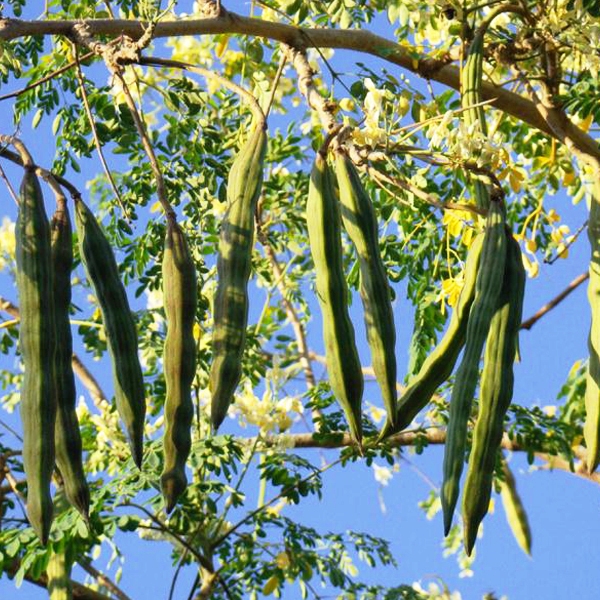Moringa oleifera

|
|
Moringa oleifera Common Names: Moringa, Drumstick tree, Horseradish
tree, Ben oil tree, Miracle tree, Malunggay Scientific
Classification Kingdom: Plantae Clade: Tracheophytes Clade: Angiosperms Clade: Eudicots Clade: Rosids Order: Brassicales Family: Moringaceae Genus: Moringa Species: M. oleifera Synonyms: Guilandina moringa L., Moringa pterygosperma Gaertn., Moringa moringa (L.) Millsp. Morphological Description Moringa oleifera is a fast-growing, deciduous tree, typically 10–12 meters
tall, with a trunk diameter up to 45 cm. Its key characteristics include: · Bark: Whitish-gray, surrounded by thick cork, becoming rough and
fissured with age (Olson, 2010). · Leaves: Tripinnate, feathery, 30–60 cm long, with 6–9 pairs of
pinnae bearing 4–6 pairs of elliptic leaflets (1–2 cm); alternate, green
(Bharali et al., 2013). · Flowers: Fragrant, hermaphroditic, in loose panicles (10–25 cm); 5
unequal, thinly veined, yellowish-white petals (1–2 cm); flowering year-round
in tropics, peaking in dry season. · Fruit: Three-sided, brown capsules (20–45 cm), pendulous,
containing 12–35 dark brown, winged seeds (1 cm diameter) (Olson, 2010). Distribution and Habitat Moringa oleifera is native to northern India but widely cultivated in
tropical and subtropical regions: · Geographic Range: Cultivated in Africa (Nigeria, Kenya,
Senegal), South/Southeast Asia (Philippines, Thailand), Caribbean, South
America (Brazil, Peru), and Pacific Islands; in Nigeria, prevalent in northern
savanna (e.g., Kano) and southern regions (e.g., Lagos) (Popoola & Obembe,
2013). · Habitat: Thrives in well-drained sandy or loamy soils (pH 5.0–7.5);
prefers 250–1,500 mm annual rainfall but is drought-resistant; grows at
elevations up to 2,000 m; found in gardens, farmlands, and disturbed areas
(Bharali et al., 2013; Fern, 2024). · Ecological Role: Pioneer species in degraded soils;
supports pollinators (bees); seeds dispersed by wind; can be invasive in some
regions (Olson, 2010). Ethnopharmacology Moringa oleifera, dubbed the "miracle tree," is a cornerstone of
traditional medicine in Nigeria, Kenya, and other regions, valued for its
nutritional and therapeutic properties. Its pharmacological potential is driven
by over 100 bioactive compounds, with studies validating extensive traditional
uses. Traditional Uses In African and Asian
ethnomedicine, M. oleifera is
used for: · Nutritional Supplementation: Leaves combat malnutrition, used as a
vegetable in Hausa and Yoruba diets (Odugbemi, 2008). · Infections: Leaf and seed pastes treat skin infections and wounds;
decoctions manage dysentery (Neuwinger, 2000). · Diabetes and Hypertension: Leaf infusions lower blood sugar and blood
pressure in Nigerian and Kenyan communities (Mathieu & Meissa, 2007). · Inflammation and Pain: Leaf and root extracts relieve arthritis,
headaches, and fever (Burkill, 1985). · Cancer and Ulcers: Leaf decoctions treat tumors and gastric
ulcers in Malawi and Senegal (Popoola & Obembe, 2013). · Reproductive Health: Leaves enhance lactation; roots used as
contraceptives in some cultures (Neuwinger, 2000). Pharmacological Studies Pharmacological studies
have validated numerous traditional uses of M. oleifera, focusing on its leaves, seeds, and roots: · Antidiabetic Activity: Ethanolic leaf extracts use for Anti-diabetes. · Antimicrobial Activity: Methanolic leaf extracts inhibited *Staphylococcus
aureus* (MIC: 0.5 mg/mL), *Escherichia coli* (MIC: 1 mg/mL), and *Candida
albicans* (MIC: 2 mg/mL), with isothiocyanates disrupting microbial membranes,
validating use for infections in Nigeria (Aliyu et al., 2011). · Anti-inflammatory Activity: Leaf extracts has anti-inflammation
activity · Anticancer Activity: Niazimicin from leaves inhibited
pancreatic cancer cell growth (IC50: 5 µg/mL) by inducing apoptosis via NF-κB
suppression, supporting Malawi’s use for tumors (Berkovich et al., 2013).
· Cardioprotective Activity: Leaf powder (6 g/day) reduced LDL
cholesterol by 14% and blood pressure by 10 mmHg in hypertensive patients after
8 weeks, with β-sitosterol and moringinine relaxing vascular smooth muscle,
validating Yoruba use for hypertension (Afiaenyi et al., 2023). ⚠ Safety Considerations: Moringa oleifera is generally safe at
therapeutic doses, but some risks are noted: Root and Bark: Contain alkaloids
(e.g., moringinine) that may cause hypotension or neurological effects at high
doses; not recommended for consumption (Neuwinger, 2000). Drug Interactions:
Inhibits cytochrome P450 enzymes (e.g., CYP3A4), potentially reducing efficacy
of drugs like antihypertensives (Monera et al., 2008). Pregnancy: Root extracts
may have abortifacient effects; use contraindicated in pregnancy (Fahey, 2005).Therapeutic
doses (e.g., 6 g/day leaf powder) are safe for most adults; expert guidance is
recommended for prolonged use or with medications (Anwar et al., 2007). Additional Information · Nutritional Value: Leaves contain 27% protein, 7 times more
vitamin C than oranges, and 4 times more calcium than milk; used to combat
malnutrition in Africa (Islam et al., 2021). · Water Purification: Seed powder (50–150 mg/L) reduces water
turbidity by 90% and bacterial load by 99%, used in rural Nigeria and Malawi
(Lea, 2010). · Oil Production: Seeds yield 40% ben oil, rich in behenic
acid, used in cosmetics and cooking; stable against rancidity (Anwar et al.,
2007). · Agricultural Uses: Leaf extracts increase maize yields by
20–30% when used as a foliar spray, adopted in Kenyan farming (Popoola &
Obembe, 2013). References
External Links More Pictures |
|
| Compounds of Moringa oleifera |
|
| References |